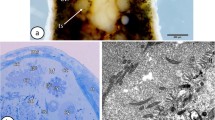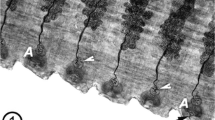Abstract
Male internal genitalia of eriophyoid mites comprise cuticle lined (anterior genital apodeme, genital chamber and ductus ejculatorius) and soft (paired vasa deferentia and single testis) organs. Three-dimensional reconstructions based on autofluorescence show that a thin-walled genital chamber is usually situated in a transverse plane and precisely copies the shape of the spermatophore. A thin vertical longitudinal plate (homologous to female longitudinal bridge) joins the genital chamber and ventral genital cuticle. The anterior genital apodeme is a separate vertical plate situated ahead of the genital chamber and provides a rigid support for it. The brightly autofluorescent ductus ejaculatorius starts from the posterior extremity of the genital chamber and goes backward. Proximally, the ductus ejaculatorius is tube-like, whereas distally, it is expanded into a sac. Confocal laser scanning microscopy observations on males, stained with phalloidin, indicate that the proximal ductus ejaculatorius is devoid of muscles whereas the distal ductus ejaculatorius possesses well-developed musculature (the “spermatophore pump”), appearing in 3D reconstructions as a hollow sphere with three apertures: one anterior and two posterior. Two thin-walled sausage-like vasa deferentia join the distal ductus ejaculatorius with a large single testis, each junction is encircled by a strong, ring-shaped muscle (musculus sphincter testiculodeferentis). Thin muscular fibers of the wall of the testis form a net-like pattern consisting of distinct polygonal cells. The topography of the male internal genitalia and musculature suggests that, contrary to previous observations, the spermatophore head might be extruded first and then the spermatophore stalk appears. The possible role of visceral and skeletal musculature, in the process of the expulsion of a spermatophore, is discussed.









Similar content being viewed by others
References
Alberti G, Coons LB (1999) Acari: mites. In: Harrison FW, Foelix RF (eds) Microscopic anatomy of invertebrates. Chelicerate arthropoda, vol 8C. Wiley, New York, pp 515–1265
Alberti G, Nuzzaci G (1996) Oogenesis and spermatogenesis. In: Lindquist EE, Sabelis MW, Bruin J (eds) Eriophyoid mites: their biology, natural enemies and control. World crop pests 6. Elsevier, Amsterdam, pp 151–167
Amrine JW Jr, Manson DCM (1996) Preparation, mounting and descriptive study of Eriophyoid mites. In: Lindquist EE, Sabelis MW, Bruin J (eds) Eriophyoid mites: their biology, natural enemies and control. World crop pests 6. Elsevier, Amsterdam, p 383
Amrine JW Jr, Stasny TA, Flechtmann CHW (2003) Revised keys to the world genera of the Eriophyoidea (Acari: Prostigmata). Indira Publ. House, Michigan, p 244
Chetverikov PE (2011) Phytoptus atherodes n. sp. (Acari: Eriophyoidea: Phytoptidae) and a supplementary description of Phytoptus hirtae Roivainen 1950 from sedges (Cyperaceae). Zootaxa 3045:26–44
Chetverikov PE (2014a) Comparative confocal microscopy of internal genitalia of phytoptine mites (Eriophyoidea, Phytoptidae): new generic diagnoses reflecting host-plant associations. Exp Appl Acarol 62(2):129–160. doi:10.1007/s10493-013-9734-2
Chetverikov PE (2014b) Distal oviduct and genital chamber of eriophyoids (Acariformes, Eriophyoidea): refined terminology and remarks on CLSM technique for studying musculature of mites. Exp Appl Acarol 64(4):407–428
Chetverikov PE, Petanović R, Sukhareva SI (2009) Systematic remarks on eriophyoid mites from the subfamily Phytoptinae Murray, 1877 (Acari: Eriophyoidea: Phytoptidae). Zootaxa 2070:63–68
Chetverikov PE, Beaulieu F, Cvrković T, Vidović B, Petanović R (2012) Oziella sibirica (Eriophyoidea: Phytoptidae), a new eriophyoid mite species described using confocal microscopy and COI barcoding. Zootaxa 3560:41–60
Chetverikov PE, Cvrković T, Vidović B, Petanović RU (2013) Description of a new relict eriophyoid mite, Loboquintus subsquamatus n. gen. & n. sp. (Eriophyoidea, Phytoptidae, Pentasetacini) based on confocal microscopy, SEM, COI barcoding and novel CLSM anatomy of internal genitalia. Exp Appl Acarol 61(1):1–30
Chetverikov PE, Beaulieu F, Belyavskaya A, Rautian MS, Sukhareva SI (2014a) Confocal microscopy and new genitalic characters: integrative redescription of a relict mite, Pentasetacus araucariae (Eriophyoidea, Phytoptidae). Exp Appl Acarol 63(2):123–155
Chetverikov PE, Craemer C, Vishnyakov AE, Sukhareva SI (2014b) CLSM anatomy of internal genitalia of Mackiella reclinata n. sp. and systematic remarks on eriophyoid mites from the tribe Mackiellini Keifer, 1946 (Eriophyoidea, Phytoptidae). Zootaxa 3860(3):261–279
Chetverikov PE, Cvrković T, Makunin A, Sukhareva S, Vidović B, Petanović R (2014c) Basal divergence of Eriophyoidea (Acariformes, Eupodina) inferred from combined partial COI and 28S gene sequences and CLSM comparative genital anatomy. Abstract book, XIV International Congress of Acarology, 13–18th, July 2014, Kyoto, Japan, p 62
Chetverikov PE, Desnitskiy AG, Navia D (2015) Confocal microscopy refines generic concept of a problematic taxon: rediagnosis of the genus Neoprothrix and remarks on female anatomy of eriophyoids (Acari: Eriophyoidea). Zootaxa 3919(1):179–191
de Lillo E (1991) Preliminary observations of ovoviviparity in the gall-forming mite, Aceria caulobius (Nal.) (Eriophyoidea: Eriophyidae). In The Acari. Springer, Netherlands, pp 223–229
Dobrivojević K, Petanović R (1982) Fundamentals of acarology. Slovo Ljubve, Belgrade (in Serbian)
Flechtmann CH, Etienne J (2002) New records of plant mites (Acari, Acaridae, Tetranychidae) from Guadeloupe and Marie Galante with descriptions of five new eriophyid species. Zootaxa 47:1–16
Helle W, Wysoki M (1996) Chapter 1.3.2 Arrhenotokous parthenogenesis. In: Lindquist EE, Sabelis MW, Bruin J (eds) Eriophyoid mites: their biology, natural enemies and control. World crop pests, 6. Elsevier, Amsterdam, pp 169–172
Li H-S, Xue X-F, Hong X-Y (2014) Homoplastic evolution and host association of Eriophyoidea (Acari, Prostigmata) conflict with the morphological-based taxonomic system. Mol Phyl Evol 78:185–198
Lindquist EE (1996) Phylogenetic relationships. In: Lindquist EE, Sabelis MW, Bruin J (eds) Eriophyoid mites: their biology, natural enemies and control. World crop pests, 6. Elsevier, Amsterdam, pp 301–327
Michalska K, Skoracka A, Navia D, Amrine JW (2010) Behavioural studies on eriophyoid mites: an overview. Exp Appl Acarol 51(1–3):31–59
Navia D, Flechtmann CH, Amrine JW Jr (2005) Supposed ovoviviparity and viviparity in the coconut mite, Aceria guerreronis Keifer (Prostigmata: Eriophyidae), as a result of female senility. Int J Acarol 31(1):63–65
Nuzzaci G, Alberti G (1996) Internal anatomy and physiology. In: Lindquist EE, Sabelis MW, Bruin J (eds) Eriophyoid mites: their biology, natural enemies and control. World crop pests, 6. Elsevier, Amsterdam, pp 101–150
Nuzzaci G, Solinas M (1984) An investigation into sperm formation, transfer, storage, and utilization in eriophyid mites. In: Griffiths DA, Bowman CE (eds) Acarology vol 6(1), pp 491–503
Oldfield GN, Michalska K (1996) Chapter 1.4.2 Spermatophore deposition, mating behavior and population mating structure. In: Lindquist EE, Sabelis MW, Bruin J (eds) Eriophyoid mites: their biology, natural enemies and control. World crop pests, 6. Elsevier, Amsterdam, p 185
Oldfield GN, Hobza RF, Wilson NS (1970) Discovery and characterization of spermatophores in the Eriophyoidea (Acari). Ann Entomol Soc Am 63(2):520–526
Popp E (1967) Die Begattung bei den Vogelmilben Pterodectes Robin (Analgesoidea, Acari). Z Morph Ökol Tiere 59:1–32
Shevchenko VG, Bagnyuk IG, Sukhareva SI (1991) A new family of Pentasetacidae (Acariformes, Tetrapodili) and its role in treatment of the origin and evolution of the group. Zool ZH 70(5):47–53
Sternlicht M, Goldenberg S (1971) Fertilisation, sex ratio and postembryonic stages of the citrus hud mite Aceria sheldoni (Ewing) (Acarina, Eriophyidae). Bull Entomol Res 60(03):391–397
Sternlicht M, Griffiths DA (1974) The emission and form of spermatophores and the fine structure of adult Eriophyes sheldoni Ewing (Acarina, Eriophyoidea). Bull Entomol Res 63(04):561–565
Sukhareva SI (1994) Family Phytoptidae Murray 1877 (Acari: Tetrapodili), its consisting, structure and suggested ways of evolution. Acarina 2(1–2):47–72
Witaliṅski W (2014) Gonads and gametogenesis in astigmatic mites (Acariformes: Astigmata). Arthropod Struct Dev 43:323–340
Acknowledgments
I am grateful to Prof. J. Amrine (West Virginia State University, USA) and three other (anonymous) reviewers for their comments and linguistic corrections. This study was supported by Russian Foundation of Basic Research (RFBR grant #15-34-20490).
Author information
Authors and Affiliations
Corresponding author
Rights and permissions
About this article
Cite this article
Chetverikov, P.E. Confocal microscopy reveals uniform male reproductive anatomy in eriophyoid mites (Acariformes, Eriophyoidea) including spermatophore pump and paired vasa deferentia. Exp Appl Acarol 66, 555–574 (2015). https://doi.org/10.1007/s10493-015-9924-1
Received:
Accepted:
Published:
Issue Date:
DOI: https://doi.org/10.1007/s10493-015-9924-1




